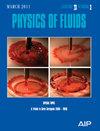Numerical investigation of wingtip aerodynamic interference of two flapping wings on opposite sides
IF 4.1
2区 工程技术
Q1 MECHANICS
引用次数: 0
Abstract
Aerodynamic interference occurs at the wingtips when flying organisms fly in a V formation. In this paper, the wingtip aerodynamic interference of two flapping wings on opposite sides at low Reynolds numbers (Re) is numerically investigated. The effects of streamwise spacing (L1), spanwise spacing (L2), and phase angle (γ) on aerodynamic performance are considered. The results show that, compared to a single wing, a favorable combination of L1 and L2 can improve the overall thrust by 24% while keeping the overall lift essentially unchanged. In an unfavorable case, overall lift and thrust decrease by 18% and 20%, respectively. The overall aerodynamic forces are dominated by the rear wing. Analyzing the essential flow characteristics reveals the double-edged role of downwash and upwash in force generation. Moreover, it is found that the rear wing can realize the upwash/downwash exploitation by flap phasing, turning an unfavorable situation into a favorable one. The key flow physics behind this transformation lies in the relationship between the direction of wing motion and the direction of fluid velocity induced by vortices. These findings provide valuable insights into the understanding of biological phenomena and the design of new flapping wing vehicles.两侧拍翼的翼尖气动干扰数值研究
当飞行生物以 V 形编队飞行时,翼尖会发生气动干扰。本文对低雷诺数(Re)条件下对侧两翼拍动时的翼尖气动干涉进行了数值研究。考虑了流向间距 (L1)、跨向间距 (L2) 和相位角 (γ) 对气动性能的影响。结果表明,与单翼相比,L1 和 L2 的有利组合可将整体推力提高 24%,同时保持整体升力基本不变。在不利的情况下,总升力和推力分别减少 18% 和 20%。整体气动力由尾翼主导。对基本流动特性的分析表明,下冲和上冲对力的产生具有双重作用。此外,研究还发现尾翼可以通过襟翼相位实现上冲/下冲的利用,将不利情况转化为有利情况。这种转变背后的关键流动物理学原理在于机翼运动方向与涡流诱导的流体速度方向之间的关系。这些发现为理解生物现象和设计新型拍翼飞行器提供了宝贵的见解。
本文章由计算机程序翻译,如有差异,请以英文原文为准。
求助全文
约1分钟内获得全文
求助全文
来源期刊

Physics of Fluids
物理-力学
CiteScore
6.50
自引率
41.30%
发文量
2063
审稿时长
2.6 months
期刊介绍:
Physics of Fluids (PoF) is a preeminent journal devoted to publishing original theoretical, computational, and experimental contributions to the understanding of the dynamics of gases, liquids, and complex or multiphase fluids. Topics published in PoF are diverse and reflect the most important subjects in fluid dynamics, including, but not limited to:
-Acoustics
-Aerospace and aeronautical flow
-Astrophysical flow
-Biofluid mechanics
-Cavitation and cavitating flows
-Combustion flows
-Complex fluids
-Compressible flow
-Computational fluid dynamics
-Contact lines
-Continuum mechanics
-Convection
-Cryogenic flow
-Droplets
-Electrical and magnetic effects in fluid flow
-Foam, bubble, and film mechanics
-Flow control
-Flow instability and transition
-Flow orientation and anisotropy
-Flows with other transport phenomena
-Flows with complex boundary conditions
-Flow visualization
-Fluid mechanics
-Fluid physical properties
-Fluid–structure interactions
-Free surface flows
-Geophysical flow
-Interfacial flow
-Knudsen flow
-Laminar flow
-Liquid crystals
-Mathematics of fluids
-Micro- and nanofluid mechanics
-Mixing
-Molecular theory
-Nanofluidics
-Particulate, multiphase, and granular flow
-Processing flows
-Relativistic fluid mechanics
-Rotating flows
-Shock wave phenomena
-Soft matter
-Stratified flows
-Supercritical fluids
-Superfluidity
-Thermodynamics of flow systems
-Transonic flow
-Turbulent flow
-Viscous and non-Newtonian flow
-Viscoelasticity
-Vortex dynamics
-Waves
 求助内容:
求助内容: 应助结果提醒方式:
应助结果提醒方式:


